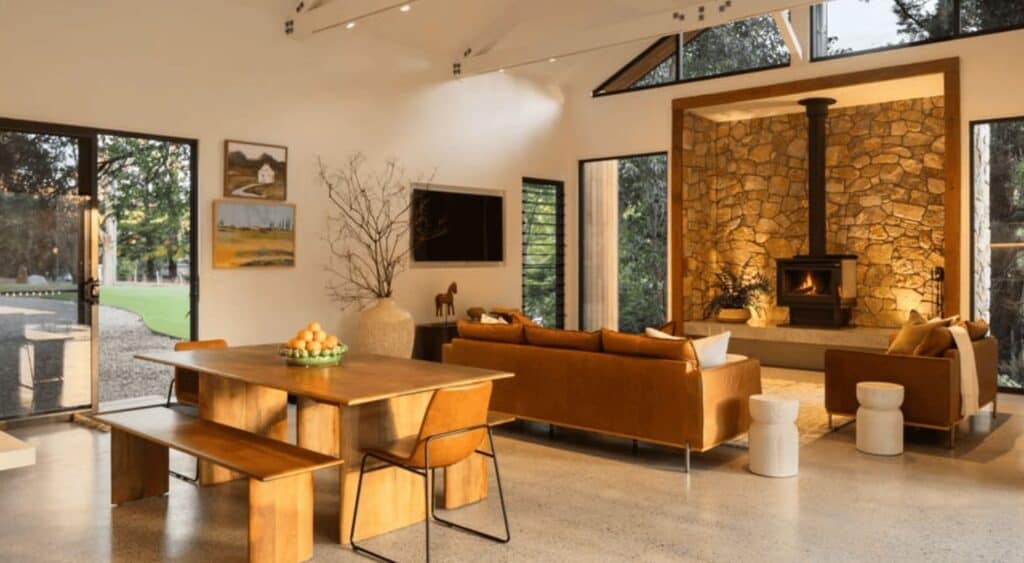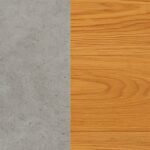The Ultimate Guide to Maintaining Polished Concrete Floors
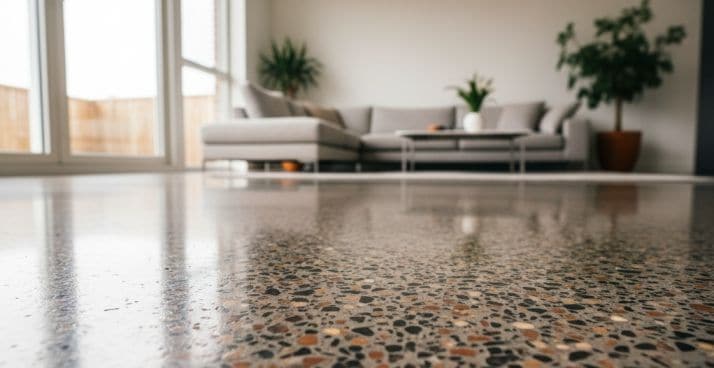
Polished concrete has become a favourite across Perth homes and businesses for its sleek look, long lifespan, and minimal upkeep. It handles daily wear better than most alternatives, it looks modern, and it is easy to clean. Like any surface, it still needs a little care to stay in top condition. The good news is that a simple, consistent routine keeps your floor looking as good as the day it was finished.
In this guide, you will learn how to maintain polished concrete day to day, what to do each week and month, and how to keep on top of long-term care. You will also see how it compares with other flooring types on cost and durability over time, with tips tailored to Perth’s climate and coastal conditions.
Why Proper Maintenance Matters
Polished concrete is tough, but it is not indestructible. Dust and grit can act like sandpaper underfoot, slowly dulling the surface if they are not removed. Spills that sit for too long may stain, especially in kitchens or cafes. Small amounts of neglect add up, which is why routine care is so valuable.
Looking after the surface protects the investment you made in your flooring. A few minutes each week can save you from bigger costs later, such as premature resealing or refinishing. Maintenance also supports safety. A clean, well-kept surface has more consistent grip, which matters in busy homes and commercial spaces.
With a simple plan, you keep the original sheen, reduce overall cleaning effort, and extend the life of your floor. The steps below set you up for strong results without fuss.
Daily Care Tips
Sweep or Vacuum Regularly
Loose dust and grit are the main culprits that dull polished concrete. A quick daily sweep or vacuum removes the fine particles that cause micro-scratches. Use a soft-bristle broom or a vacuum with a hard-floor head. In high-traffic spaces, a second light pass in the afternoon keeps everything fresh.
Pay attention to entries and kitchen zones where crumbs and sand collect. If you are near the coast, fine salt can settle indoors. Regular removal protects the finish and keeps the floor looking sharp.
Mop with Neutral Cleaner
A PH-neutral cleaner mixed with warm water is the safest option for polished concrete. Avoid bleach, ammonia, citrus, vinegar, or any acidic or harsh products. These can etch or dull the surface over time. A microfibre mop lifts dirt instead of pushing it around, which reduces streaks and residue.
Change the mop water as needed so you are not spreading dirty water across clean sections. If you spill oil, wine, or coffee, clean it up straight away to prevent stains. Quick action is the simplest way to keep the surface spotless.
Weekly and Monthly Care
Alongside daily habits, a weekly routine locks in the long-term finish. Give the whole area a thorough vacuum, then mop with a PH-neutral cleaner to remove fine build-up. This keeps the sheen even and reduces the need for heavy deep cleans later on.
Each month, take a closer look. Check for scuffs near chairs, stools, or entry points. Fit felt pads to chair and table legs to reduce friction. Place good-quality floor mats at main doors to stop sand and grit at the source, which is particularly useful in coastal suburbs and sandy backyards.
Microfibre mop once a week to remove fine particles missed by sweeping.
Spot clean spills straight away to prevent stains setting into the surface.
Use mats in entryways to reduce tracked-in sand and dirt.
Long-Term Maintenance
Professional Resealing
Polished concrete benefits from resealing every two to three years, depending on use. A quality sealer refreshes protection against spills and helps retain the desired level of gloss. Commercial spaces or busy family kitchens may need attention sooner. Proper preparation and application make a big difference to results, so professional work is recommended.
Ask your contractor which sealer suits your finish and usage. Indoor living rooms, retail spaces, and commercial kitchens are all used differently. Matching the product to the environment gives better longevity and easier cleaning.
High-Traffic Areas
High-traffic zones wear faster than the rest of the floor. If you notice dull patches along walkways or in front of counters, targeted burnishing can restore the sheen without a full grind. Regular inspection helps you act early and avoid larger jobs later.
Simple additions help as well. Runners in long corridors, protective glides under furniture, and sensible shoe policies in commercial spaces all reduce wear. These choices keep your floor looking consistent from wall to wall.
Comparing Maintenance Costs
Here is how polished concrete stacks up against other popular flooring types in Perth over a ten-year period:
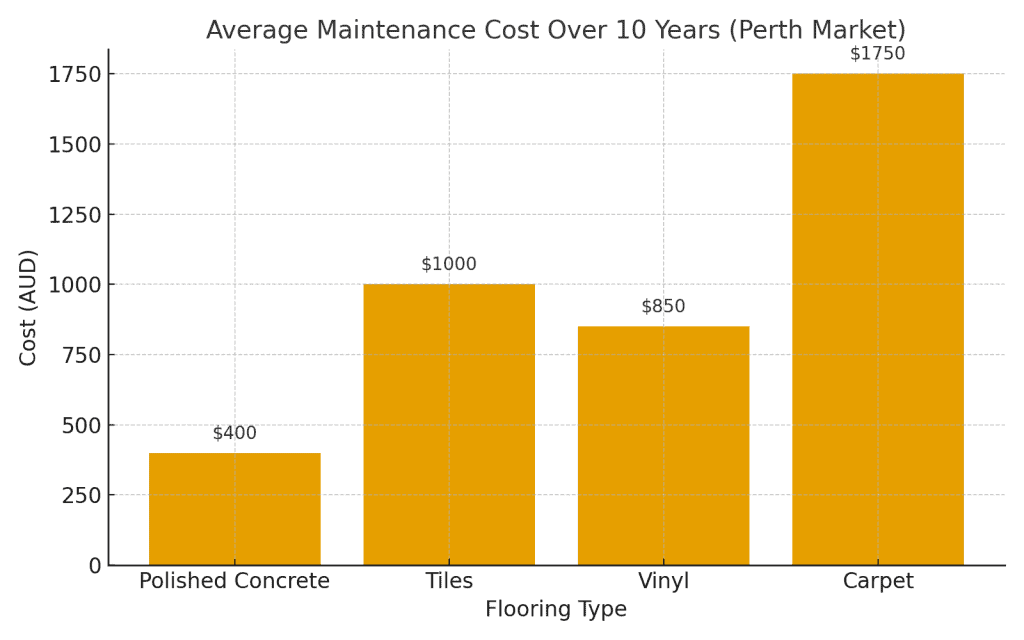
| Flooring Type | Average Maintenance Cost (10 Years) | Typical Durability |
|---|---|---|
| Polished Concrete | Low ($300–$500) | 25+ years |
| Tiles (ceramic or porcelain) | Medium ($800–$1,200) | 15–20 years |
| Vinyl Flooring | Medium ($700–$1,000) | 10–15 years |
| Carpet | High ($1,500–$2,000) | 8–10 years |
Data based on WA market averages. Figures are indicative only. This comparison shows why polished concrete is often the smarter long-term investment.
Durability Over Time
Cost is one part of the picture. The other is lifespan. Polished concrete usually outlasts carpet, vinyl, and many tiled installations when maintained well. This is where the value becomes clear for Perth homes and businesses. The graph below gives a simple view of expected lifespans.
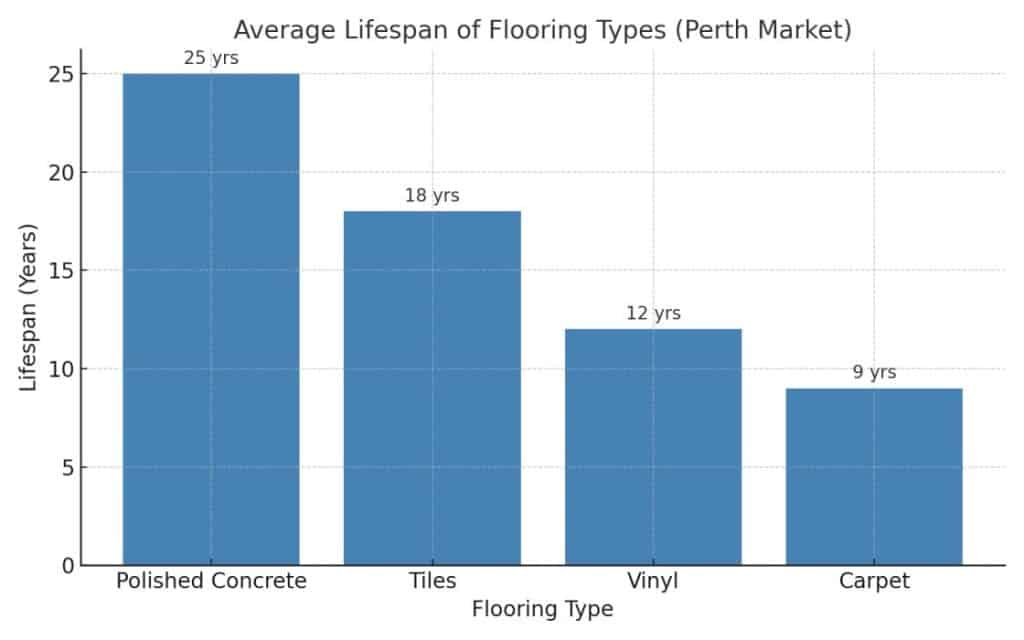
| Flooring Type | Average Lifespan (Years) | Indicative Range |
|---|---|---|
| Polished Concrete | 25 | 25+ years |
| Tiles (ceramic or porcelain) | 18 | 15–20 years |
| Vinyl Flooring | 12 | 10–15 years |
| Carpet | 9 | 8–10 years |
Lifespan varies with use, environment, and maintenance. A consistent care routine helps each surface reach the upper end of its range.
These averages vary with usage and care, but the pattern holds. A durable surface that is easy to clean and simple to maintain is more likely to look good and last longer. Over time, that means fewer replacements and a better overall return.
Outdoor Polished Concrete
Perth’s hot summers and coastal conditions call for a slightly different approach outdoors. Honed or polished outdoor concrete can be exposed to UV, sea air, and pool chemicals. These factors can wear the surface faster than indoor areas, so a small amount of extra care goes a long way.
Rinse regularly with a garden hose to remove salt and dust.
Use a mild cleaner for deeper washes in alfresco and pool zones.
Reseal more often if the area receives heavy sun or chlorine exposure.
Select slip-resistant finishes around pools and paths to balance style and safety.
For reliable guidance on compliance and safety, see the Western Australian Building and Energy Commission. It is a trusted source for building standards and consumer advice in WA.
Key Benefits of Regular Maintenance
A consistent maintenance routine delivers clear benefits that add up over time. The surface stays cleaner, the sheen stays even, and the floor lasts longer. These improvements reduce hassle and cost for both homes and workplaces.
Keeps the floor looking sleek and modern, even in high-traffic spaces.
Extends lifespan compared with carpet, vinyl, and many tiled surfaces.
Reduces cleaning time and the need for harsh chemicals.
Supports safety with better grip and fewer dust-related issues.
Final Words
Maintaining a polished concrete floor is straightforward. Daily sweeping, neutral mopping, and a sensible weekly and monthly routine keep the surface in great shape. Add professional resealing when needed, and your floor will look the part for decades.
Get in Touch Today
Ready to keep your polished concrete floor in top condition or need advice on resealing and finish options?
Call Precision Polished Concrete on (08) 9249 2551 or book your free quote today.

